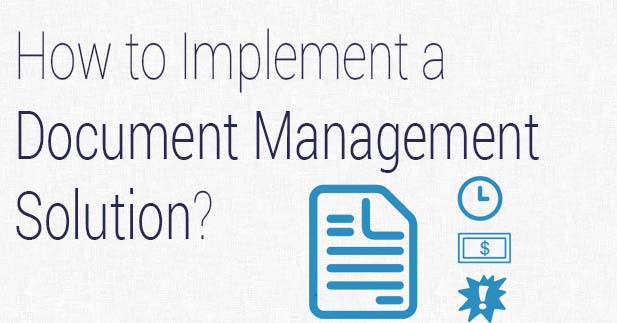How long does it take to implement a Document Management System (DMS)? What should I expect with pricing, the time frame, and common issues?
The best way of approaching implementation is through the eyes of those that will have access.
Document Management Systems (DMS) provide many features for meeting a team’s document needs. As you consider the ins-and-outs of a system, you should already know how your people will be using it.
Executing a successful implementation comes down to knowing what problems will be solved, even before choosing a solution.
The time frame, costs, and challenges should be the areas of focus for both your people and the vendor’s implementation specialists.
How long should I expect implementation to last?
The amount of time it takes to implement a new DMS solution depends on the scale of your project.
The following stages should be planned before making a buying decision:
- Preparation: Determine who the decision makers and end-users are.
- Milestones: Set specific dates for how the solution will be scaled out across your organization.
- Document Workflow: Estimate how many files need to be initially imported and how many will be created regularly.
- Storage: Measure your hardware capacity for an on-premise solution, or learn how much cloud storage will meet your needs.
The amount of time it takes to move your data to the new system and organize it is what will determine the time frame. From start to finish, it typically takes 60-90 days for a standard DMS and 12-18 months for similar enterprise solutions, hinging on an accurate communication plan for meeting milestones.
Issues will arise along the way, but the most important date to stick to is the initial go-live with a pilot group for testing the solution.
How much do Document Management Systems typically cost?
Vendors tend to guard the price of their solutions because it depends on a few factors.
On-premise solutions require a high up front cost due to the price of buying hardware along with licensing fees, whereas cloud solutions are paid for through a monthly or annual subscription fee.
Whether through a cloud solution or on-premise, pricing will primarily depend on how many accounts must be managed.
- For cloud-based solutions, some have estimated you can expect to pay between $20-$50/user/month, while others have estimated the price adds up to $400-$1,000/user/year.
- For on-premise solutions, some have estimated you can expect to pay $5,000-$6,000/device for hosting the solution on top of a licensing fee of $350-$500/user/year.
Software costs are very subjective, and depend on the solution’s approach to managing data as well as additional services needed.
Note: Many cloud solutions are priced even lower than $20/user/month, and vendors often offer exclusive deals for clients with 25+ users.
What are the most common implementation challenges?
Implementation challenges are not IT problems.
The truth is that your employees will likely need to change. A new solution often means a compromise on the easiest way of accessing the system so everyone can participate.
Most issues during implementation stem from misunderstandings between end-users and the vendor. Luckily, preparation for the following three challenges greatly help:
1. Gaining Buy-in – Even before choosing a solution, employees should be asked to join a conversation on what problems it will solve. Incorporating end-users early in the decision helps foster a commitment that the solution will be adopted. Once the solution is chosen, ensure that end-user needs are heard and their concerns are relayed to the vendor so that everyone understands what is required for it to be properly used.
2. Standardizing Language – Your files were likely put together by many different people. When it comes to organizing it all in one database, a common challenge is when files need to be re-thought in order to efficiently fit workflows across users. When categorizing documents in a DMS, the idea is to allow users to find anything they need as quickly as possible. For example, you may need to find a sales document while also pulling up a marketing document because they both relate to “Thought Leadership.” The exact way employees refer to their processes and files through phrasing and keywords are a major factor for how they’re found in the system, making the language used to describe these files very important.
3. Granting Permissions – Vendors approach user access features many different ways in an attempt to simplify privileges. The process is typically tedious and requires forethought on what information will be most useful to whom. Some solutions automate role-based permissions so that as you standardize the language through metadata, users are granted access based on their job duties. The personnel setting up the system will need a comprehensive understanding of who needs access to what content.
Proper implementation is a high priority. The best indication of success is when this process is strategized even before the buying decision.
For more advice on DMS implementation, check out these useful vendor resources:

i m in need of getting a best project for Electrical Document Management Systems.Can Any body help in submitting the project
Hi! It’s hard to specify the “best” document management system (DMS) because every organization has different needs. I’d suggest figuring out:
1.) Why you need a DMS.
2.) What capabilities you need from a DMS.
3.) Which solution has the “best” features and capabilities to satisfy your needs.
If you need a place to get started, our DMS Definitive Guide contains all you need to know about features, trends and challenges. I’d also suggest taking a look at our detailed reviews to compare top DMS solutions. Good luck!